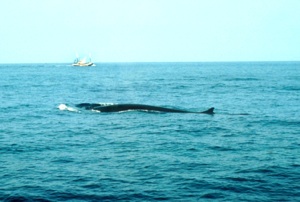Marine Mammal Species Description
Fin Whale
Balaenoptera physalus
(Linnaeus, 1758)

Photo credit: Jose Cort, NOAA Photo Library
Classification
Order: Cetacea
Family: Balaenopteridae
Alternate Common Names: Common rorqual, finback, fin-backed whale, finner, herring whale, razorback
Status: ESA Endangered/ MMPA Depleted
Description:
Length: 69-85 ft (21- 26 m); maximum: 89 ft (27 m)
Weight: 99,200-176,400 lbs (45,000-80,000 kg); maximum: 200,621 lbs (91,000 kg)
Fin whales are sexually dimorphic, with females being larger than males. Fin whales living in the Northern Hemisphere are typically smaller than those in the southern hemisphere. From above their head has a 'V' shape. They have a long falcate dorsal fin located about two-thirds the distance back on their body from the tip of their nose. They have 50-100 ventral grooves or pleats that extend from their lower jaw to their navels. These whales are in the suborder Mysticeti, or the baleen whales. Baleen whales do not have teeth, but have plates attached to their upper jaws. These baleen plates are hard, but flexible, which baleen whales use to filter their food from the water. They are black or dark-gray above and on the sides, and white on their belly and undersides. They are unique because the color on the right and left sides of their heads are not the same. The lower left jaw is dark and the lower right jaw is white.
Habitat:
Fin whales occur in coastal to deep ocean waters. These whales occur by themselves, in small groups of two or three, and occasionally larger groups of individuals in areas of abundant food.
Feeding:
Fin whales eat krill and some small schooling fish species. They feed by gulping or lunging taking in large amounts of water. The ventral grooves on their throat allow their throat to expand and take in large amounts of water. They close their mouth and force the water out and strain the food with their baleen. Researchers have estimated that fin whales can eat 3-4 tons (6,000-8,000 lbs; 2,700-3,600 kg) of food in a day. Fin whales have been recorded diving to depths of 656 ft (200 m) for three to ten minutes at a time.
Reproduction:
Male and female fin whales reach sexual maturity at 6-8 years old. In the Northern hemisphere, sexually mature males are at least 57 ft (17.5 m) and females are 61 ft (18.5 m) long. The breeding season for fin whales in the Northern Hemisphere is during the winter months. Females give birth about every two years. The gestation period lasts around 11 months. A single calf is born and nursed for about 6-8 months. Occasionally a female will give birth to twins. They remain with their mother around 6 more months until they become independent.
Other:
The estimated life span for fin whales is about 80-90 years old. Fin whales can reach speeds of up to 29 miles per hour (46 km per hour), but normally swim at 6-9 m/h (9-15 km/h). Research suggests that fin whales continue to use the feeding grounds for the rest of their life that they are taken to with their mothers in their first year. Fin whales have been recorded diving down to 1,800 ft (550 m) deep.
Distribution / Range:
Fin whales occur worldwide. Most fin whales are probably migratory, spending warmer summer months feeding in higher latitude areas (closer to the polar regions) and winter months closer to the tropics and subtropics. Some research suggests that some individuals may stay in the same region year round. The Gulf Stream off the coast of the eastern United States may allow fin whales to remain farther north during colder months. Off the eastern and southern United States, fin whales are rare in the Gulf of Mexico and more common north of North Carolina.
Similar species:
Fin whales are most likely confused with blue, sei, and Bryde's whales. The different coloration on the right and left side of the lower jaw is the easiest way to tell these other species from fin whales.
Notes:
References:
Agular, A. 2009. Fin Whale - Balaenoptera physalus. In: Encyclopedia of Marine Mammals 2nd Ed. Perrin W.F., B. Würsig, and J.G.M. Thewissen, eds. Academic Press, New York, pp. 433-437.
American Cetacean Society. 2004. American Cetacean Society Fact Sheet. http://www.acsonline.org/factpack/finwhl.htm. Accessed January 2012.
Birchler, B., C.W. Potter, and P. Clapham. 1999. Fin whale, Balaenoptera physalus. In The Smithsonian Book of North American Mammals. Wilson, D.E. and S. Ruff, eds., 253-255. Smithsonian Institution in association with the American Society of Mammologists, Washington DC.
Jefferson, T.A., S. Leatherwood, and M.A. Webber. 1993. FAO species identification guide. Marine mammals of the world. Rome, FAO. 320 p. 587 figs.
Reilly, S.B., Bannister, J.L., Best, P.B., Brown, M., Brownell Jr., R.L., Butterworth, D.S., Clapham, P.J., Cooke, J., Donovan, G.P., Urbán, J. & Zerbini, A.N. 2008. Balaenoptera physalus. In: IUCN 2011. IUCN Red List of Threatened Species. Version 2011.2. www.iucnredlist.org. Downloaded on 09 January 2012.

 Marine Mammals of Georgia
Marine Mammals of Georgia